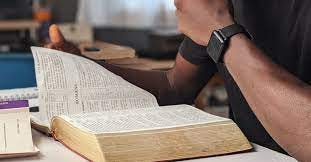If you’re a Christian, then it’s a safe bet to assume that you read the Bible some. If you don’t, then I implore you to start reading your Bible but I’ll assume you do. And I’m glad you read the Bible but now tell me, how do you read the Bible?
The question of how we, as Christians, read the Bible has captivated much of my attention. You see, anyone can read the Bible including the devil himself but reading the Bible and reading the Bible well are two very different matters. My interest is in understanding how Christians read the Bible (hermeneutics) and do so well. By well, I mean reading the Bible as participants in the mission of God since that is our calling as followers of Jesus.
Learning to read the Bible well not only provides instruction for participating in the mission of God but also mitigates the possibility of misusing scripture. By misuse, I certainly think of how the Bible can become a weapon used to oppress people, such as slave owners in American history who used the Bible to justify chattel slavery. I also think about the way some people take certain scriptures out of context to prop up certain dogmas or something like the so-called prosperity gospel of health and wealth. To be a bit more controversial, I also consider turning an ancient text originally written in a pre-scientific era into a scientific text, such as some do with the Genesis Creation narrative(s), to be a misuse of the Bible.
All that said, learning to read the Bible well is something that needs to be taught and there are more than a few books that can help teach us to better read the Bible. For your interest, I just want to provide a list of five accessible books that I believe can help us learn to read the Bible well.
Craig G. Bartholomew and Michael W. Goheen, The Drama of Scripture: Finding Our Place in the Biblical Story, 2nd ed., Grand Rapids: Baker Academic, 2014. The writers provide a narrative retelling of the entire Bible as a story told with six acts that help us understand the Bible within the grand narrative. And don’t let the “Baker Academic” fool you, as this book is very easy to read. I read the first edition, which was given to me as a gift by a Christian lady (thanks, Amy) who doesn’t have any formal theological education.
N.T. Wright, Scripture and the Authority of God: How to Read the Bible Today, reprint ed., New York: HarperOne, 2013. This book begins by addressing the authority of scripture and then how the Bible, as an authoritative text, has functioned within Christian history. Towards the end, Wright proposes a model for reading scripture so that has helped form my own understanding.
Scot McKnight, The Blue Parakeet: Rethinking How You Read the Bible, 2nd ed., Grand Rapids: Zondervan, 2018. Approaching the Bible as a story with many “Wiki-Stories,” McKnight helps us learn how to read the Bible by listening and discerning scripture. The later half demonstrates how this reading works by exploring the issue of the Bible and women in the church.
Dan Kimball, How (Not) to Read the Bible: Making Sense of the Anti-Women, Anti-Science, Pro-Violence, Pro-Slavery, and Other Crazy-Sounding Parts of Scripture, Grand Rapids: Zondervan, 2020. Written by a pastor who has had to deal with such matters, this book offers some principals for interpreting the Bible in manners that help us avoid misusing scripture. This is also a helpful resource to discuss with seekers who are hesitant to consider what the Bible says because they believe they must choose between the false dichotomies of matters like the Bible and science or the Bible and social-justice.
John Mark Hicks, Around the BIble in 80 Days: The Story of God from Creation to New Creation, Abilene: Leafwood, 2022. I’ve actually just started reading this book and am far from finished, so there’s always a risk in recommending a book that I’ve not finished reading. However, the author is both a friend and former seminary professor, so I have confidence here. The book is a series of short devotional-type readings that help us understand the story of the Bible and how that story fits within God redemptive mission of renewing creation as a new heaven and earth.
Of course, when my book Gospel Portraits: Reading Scripture as Participants in the Mission of God is released, I hope you’ll buy a copy and read it to. Yes, that sounds a little self-serving but I do believe the book will make a significant and accessible contribution in helping Christians to read the Bible well. I don’t have a release date yet but when I know, I’ll be sure to let you know.
____________________
If you enjoyed this article, please share it with others who might benefit from reading it as well. And if you haven’t done so yet, please consider signing up for my weekly newsletter that will always feature articles about the Bible, God’s mission, and the intersection of the gospel and culture. Grace and Peace to you all!


